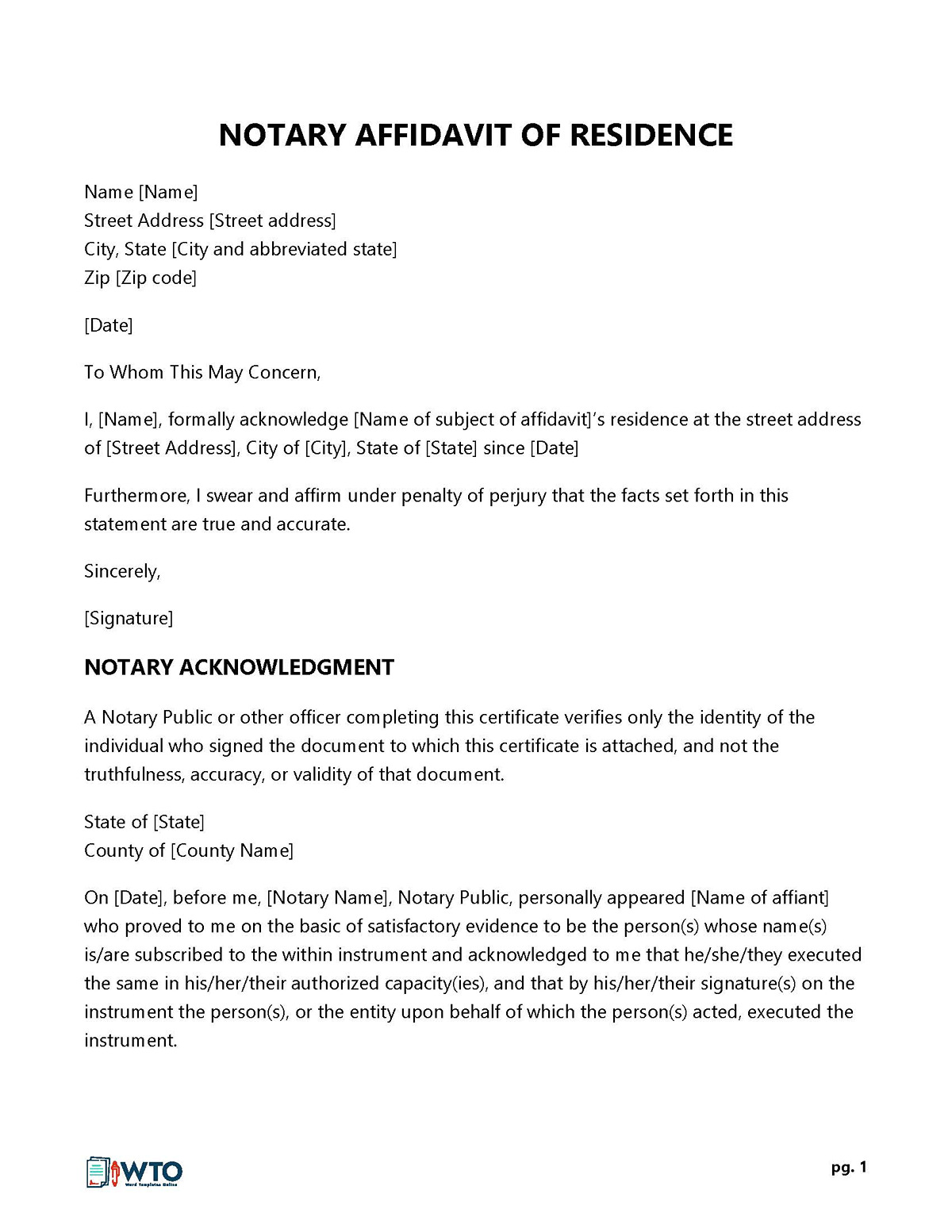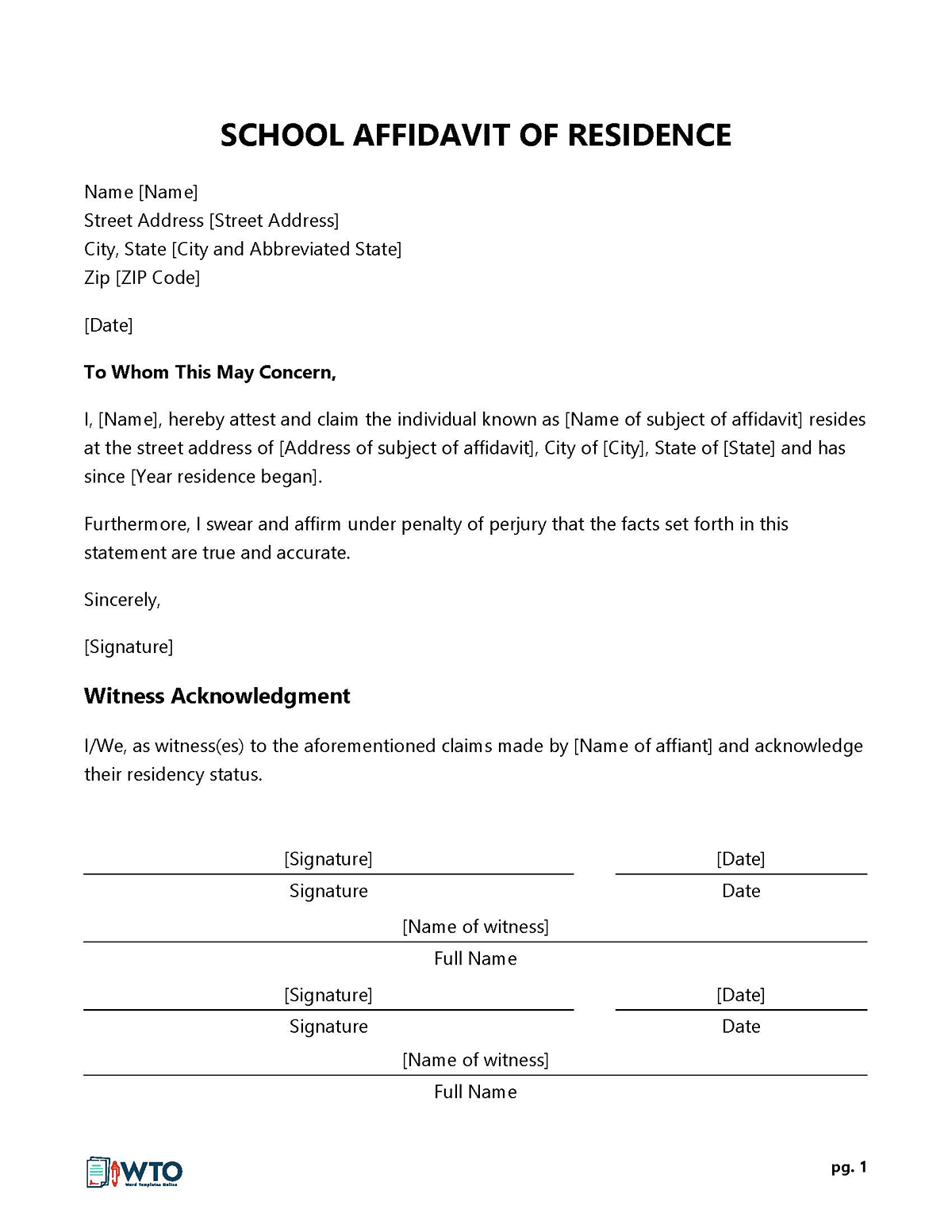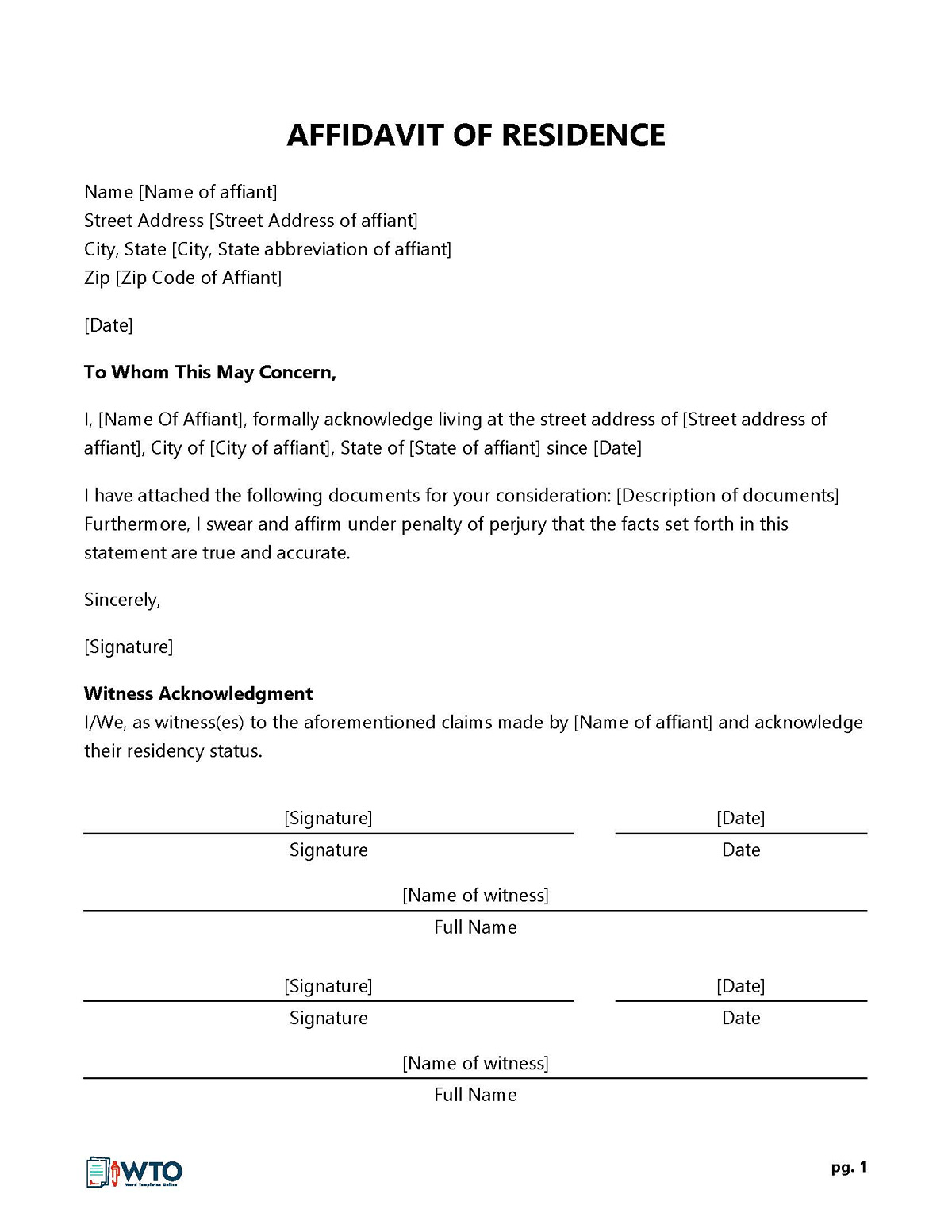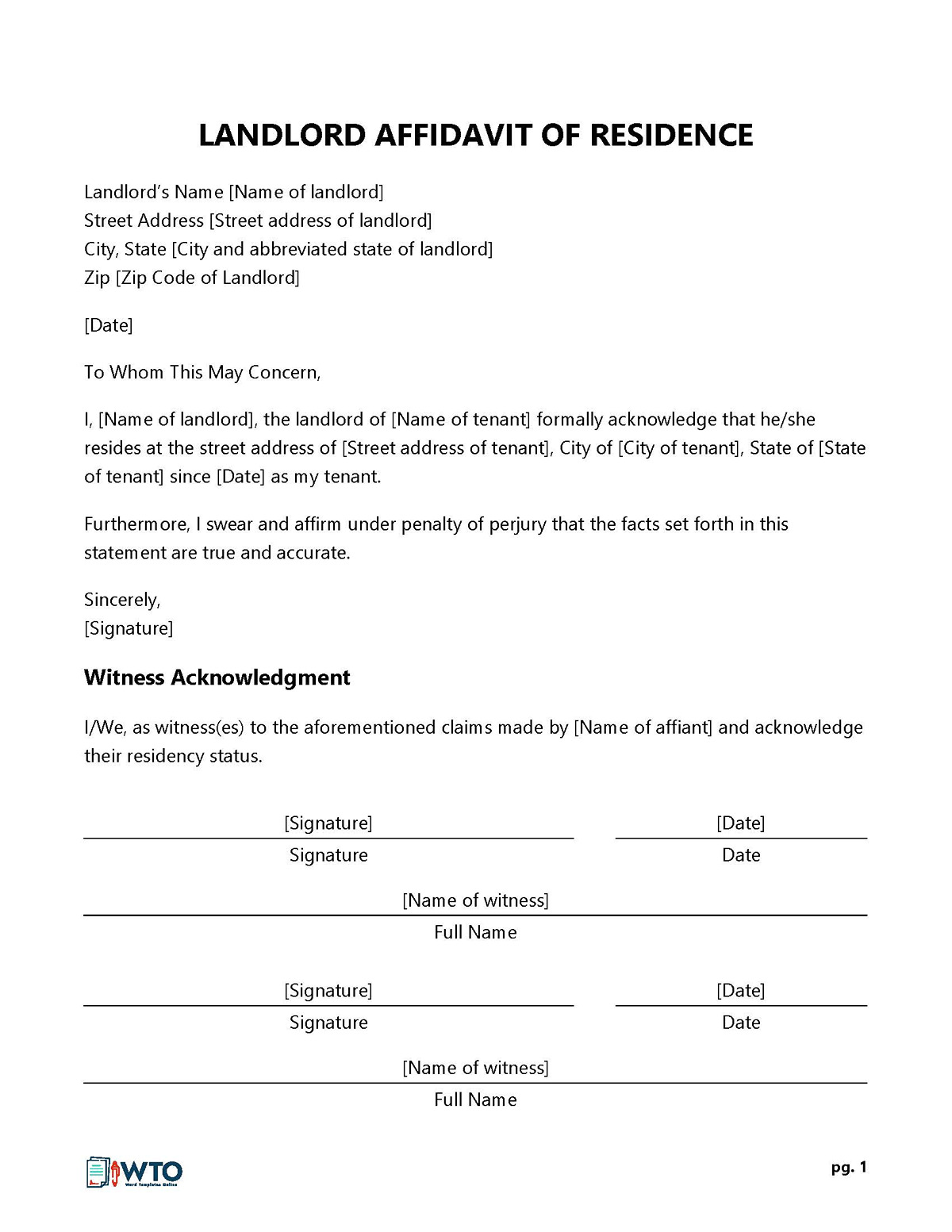A proof of residency letter is a formal statement that documents an individual’s current address.
Typically, this document is attached to other evidentiary documents to prove that the individual resides somewhere, so it is also known as an affidavit of residence. This letter can be written by a landlord, an employer, family members, or a roommate and is often enough to prove residency. If there is no accompanying proof, the letter should be notarized.
Types of Proof of Residency Letter
Depending on the person making the sworn statement or the institution requiring one, there can be different types of proof of residency letters.
The following are some of the most common letters that can prove residency:
DMV proof of residency letter

The Department of Motor Vehicles often requires at least two forms of identification that prove an individual resides within the state to apply for a driver’s license or voter registration. Proof of residency letter can accompany these other government-issued documents.
Employer proof of residency letter

A sworn statement can accompany an individual’s employment paperwork, such as their W-4, to establish residency requirements. In addition, these affidavits are commonly used when proving residency for the DMV, in-state tuition, and any immigration proceedings.
Family member proof of residency letter

This type of residency proof helps verify that an individual lives in a family residence. Typically parents or grandparents will sign this statement and issue it to a school district or State government, listing the total time the family member has been living there.
Landlord proof of residency letter

A landlord may provide this letter with the lease to verify that a tenant has been residing on their property. Therefore, it is often recommended to have this letter notarized when presenting it.
Notary public proof of residency letter

This simple letter is a sworn statement signed in front of a notary public to claim residency. Once notarized, the individual must abide by State perjury laws if they have made false claims.
School proof of residency letter

A school proof of residency letter is signed to allow an individual to attend a specific school district or apply for in-state tuition at a university. Some other pieces of documentation like a water bill should accompany the letter.
Pre-Considerations
Before starting to write and prepare the proof of residency letter, it’s essential to understand some critical aspects involved.
Depending on the type of document being prepared, you may have different requirements:
Understand the requirements of the letter
Firstly, it’s essential that you completely understand the letter’s requirements based on the organization it will be submitted to.
EXAMPLE
School districts may require that the sworn statement be accompanied by other state-issued documentation and contain information about the current address.
It is also a common requirement for many organizations to have the letter signed by the homeowner. You may also need a utility bill attached that proves the residency is in use. Depending on the institution, it is also common for notarization to be required to validate the letter.
Collect and copy supporting documents
Once you understand everything that must go along with the letter, it’s time to collect and create copies of all the documentation.
EXAMPLE
You may need to create copies of the utility bill, the current lease, or tax forms that include the address information.
tip
There are several types of documents that can be used to prove your identity and residency. For example, social security numbers, passports, council taxes, T4 or W4 slips, bank statements, voter registration, lease agreements, AdhaarCard in India, driver’s licenses, post office documents, and utility bills.
Discuss the affidavit with your landlord
In many cases, you may need your landlord’s signature on the letter. For this reason, it is best to discuss the letter with them and have them sign it. In the case of notarization, you must both be present before a notary signs it.
Make an appointment with the notary
After discussing it with your landlord and preparing all the documents, the next step is to make an appointment with a notary. Of course, not all require appointments, but it is wise to contact them beforehand to guarantee smooth proceedings.
Writing the Letter of Proof of Residency
Once you understand all the steps for creating a proof of residency letter, the next step is to draft the document.
Several critical pieces of information must be included for it to be valid:
Create a heading for the letter
The first piece of information that must be included in the letter is the heading. It should read “Affidavit of Residence” or “Proof of Residence” at the top of the page, centered and bolded. The text should also be larger than the rest of the text. As it is a formal document, professional formatting is required.
Mention the date
Next, the letter should be dated, as it is a formal legal document. Any style can be used as long as the date is placed below the header on the top right part of the document. The date on the document must match the date it will be notarized. You should place the date just two lines directly underneath the centered header. However, if you have a subject rather than a header, place the date two lines above it.
Include your contact information
Afterward, the individual’s contact information should be included on the top left. In addition, the individual’s full name, address, phone number, and email address should be written in a professional font. All of this information should go below the date and header and above the subject.
Address the recipient
Afterward, a professional salutation should start the letter. In many cases, you can directly address the institution for which the letter will be used. However, if you do not know the full title or name of the company, it is acceptable to use “To Whom It May Concern simply”.
For the body of the letter, there are two separate scenarios. First, if you are a resident, the body of the letter will be different than if you are the landlord. For this reason, this article will discuss both cases as follows:
If you are a resident
If you are a resident writing a residency letter to be provided to an official institution, specific aspects should be included within the document:
Start with your legal name
As a resident, the first element that must be included is your full legal name. As it is a legal document, only use your full name rather than any nicknames. The letter will generally start with “I, [Name]…”
Include your address
Afterward, you must state the full address where you are living. As this is a sworn statement, you should use formal wording such as “I, [Name] swear that I reside at XYZ” or “I certify that I, [Name], reside at XYZ”.
Mention the length of the period of your residence
After the full address is mentioned, the letter should include the length of time you have lived there. It is essential to be as precise as possible and, at a minimum, cite the month and year when the residency began.
Mention the other residents (if any)
Some letters may require you to mention other people who live with you. You should also include the length of time they have lived with you. This tends to be an essential piece of information when the letter is sent to a school district for your children.
Type your oath
Sworn statements require you to take an oath reiterating the veracity of the statements. This makes a sound legal document, though you may be liable to perjury charges if anything in the document is untrue.
Sign off and your signature
After that, the letter should end with a professional signoff and your signature. First, you must write your full legal name once again; then, you will sign the document before the notary. Place the signoff remarks two lines below the final sentence, then leave three or four lines of space so the letter may be signed. After this space, you may add your full typed name. Your name must appear the same in the entire letter and other supporting documents.
Date of the signature
Likewise, you should add the date underneath your signature but above your typed name. Similarly, this part should be done in front of the notary.
Leave lines for the landlord’s and notary’s signature
If the landlord must also sign the letter, space must be left for them to sign and date the sworn statement. Likewise, space should always be left for the notary public to sign at the very bottom.
If you are a landlord
If you are writing a proof of residency letter as a landlord, a different set of steps should be taken to create this sworn statement appropriately:
State the purpose of writing
The beginning of the letter should immediately state the purpose of the letter, using your full name and those of the tenants. Then, it should use formal, professional wording, as in the previous case, certifying the residency of the individual listed.
Include the address
Afterward, the full address must be included. In addition, any identifying information accompanying the address must also be included so there is no confusion in the case of multi-unit residences.
Mention the period of your tenant’s residency
As the landlord, you should state the period of the tenant’s residency, giving the exact day whenever possible. If you are required to provide the duration of the residency, this should also be listed.
Include the rent amount
Depending on the institution the letter will be given to, you may also need to include the monthly rent in the letter. Similarly, you may need to include the average cost of utilities in the letter as well.
Invite the recipient to contact you if they have a question
As the landlord, you should welcome the recipient to contact you in case they have further questions. For this reason, you should include your phone number and email address so they may reach out to you appropriately.
Signoff and your signature
As in the other case, as a landlord, you’ll need to leave a formal signoff and space for your signature and date. Again, include your full legal name, not any nicknames.
Sample of Proof of Residency Letter
It may be helpful to have a sample to guide you in drafting a proof of residency letter. For this reason, the following sample will surely help you:
sample
Affidavit of Residence
To Whom It May Concern,
I, John Doe, hereby attest to my residency at the following address:
123 Elm Street
Anytown, USA 12345
I certify that I have been residing at this address since January 20XX, and I continue to do so to the present date.
Additionally, I would like to mention that the following individuals also reside at this address:
1. Jane Smith – Since March 20XX
2. David Johnson – Since August 20XX
I solemnly affirm the truthfulness of the information provided in this Affidavit of Residence.
Sincerely,
John Doe
Signature: __________________________________
Date: _____________________________________
[space for the Landlord’s Signature and Date, if applicable]
[space for the Notary Public’s Signature and Date]
Key Takeaways
This document serves as a good sample for someone who needs to write a similar proof of residency letter for several reasons:
- The document follows a professional format with a clear heading (“Affidavit of Residence”), and proper alignment, making it easy to read and understand.
- It includes the contact information of the resident at the beginning of the letter, which is essential for verification purposes.
- The letter provides specific details about the duration of residency, mentioning both the month and year. This specificity is crucial for official purposes.
- It includes a section for listing other residents, if applicable, along with their respective move-in dates, which can be important in certain situations.
- The language used is clear and concise, making it easy for the recipient to understand the purpose of the letter and the statements being made.
- It includes a statement where the resident affirms the truthfulness of the information, which is a standard practice in such documents.
- There is a designated space for the resident’s signature, the date of signing, and a provision for the landlord’s and notary public’s signatures and dates if required.
Overall, this sample letter effectively covers all the key aspects required in a proof of residency letter and can serve as a useful sample for someone needing to create a similar document.
Free Templates




Uses
There are several types of proof of residency letters, which can serve many different purposes.
Below are some of the most common uses for these formal documents:
For utility purposes
They often require proof of address if you need to start up utilities such as electricity or internet at a specific location. These affidavits are one way to provide proof.
For government documents registration
Almost any kind of official government document requires you to prove your place of residency. From voter registration to a driver’s license, you must be able to provide evidence of your address.
For general services
Many simple services, such as renting vehicles, applying to specific programs, or registering at events, require you to provide proof of residence.
For job purpose
Almost all jobs require you to provide proof of residence for tax purposes. For that reason, one of these letters is an excellent way to certify your address.
Bank needs
Likewise, opening a bank account or applying for insurance often requires you to certify your address. In these cases, the letter may be accompanied by other documents that prove your residence.
For passport
In most countries, proof of residency is required to apply for a passport for travel. As your passport is also an essential form of identification, this application process often requires notarizing the affidavit and other forms of ID.
Tips
Before you begin drafting your letter, following these best practices is essential to ensuring you’re using the sworn statement properly.
In addition, as a formal document, you’ll want to guarantee that it is created as professionally as possible:
Save a copy for future use
You should always keep an additional copy of formal legal documents for reference. In addition, it’s wise to create several copies of the letters and all the supporting documentation given.
Format the letter professionally
Make sure the letter is typed in a formal font, such as Arial or Times New Roman. The rest of the letter should also be in the standard format, including 1-inch margins, block letter format, and non-indented paragraphs. The letter should also be single-spaced but with an additional space between each new paragraph.
Proofread the letter
Finally, as this is a legal document, it is fundamental that there are no grammatical errors or spelling mistakes. Therefore, make sure that the language is unambiguous. Again, an online spellchecking tool may be helpful to aid you in the proofreading process.
Conclusion
Proof of residency letter is a formal document that can be used for many critical bureaucratic proceedings in your life. Many events will require you to prove your address, from applying for a driver’s license to enrolling your child in a school district.This legal document is a helpful tool to supplement other forms of address verification, but each organization may require different technical details. Make sure you research and understand the elements required by the organization to which you’re delivering this affidavit.
Using a sample as a guide when drafting your letter of proof of residency may also be helpful. Ensure you follow the correct guidelines, as residents and landlords may have different processes regarding the content. Finally, follow the above best practices when drafting and revising the letter. As a legal document, many specifications must be done perfectly, especially if it will eventually be notarized.










